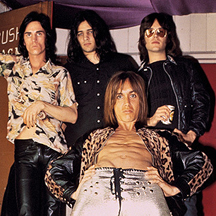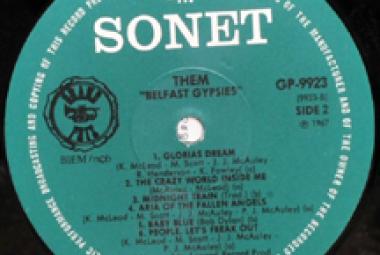THE STOOGES – Early Years
The Stooges (also known as Iggy and the Stooges) are the prototype of proto-punk. Like MC5, they are a Detroit band, or more properly an Ann Arbor band. As Stephen Thomas Erlewine observes in his Allmusic article: “Taking their cue from the over-amplified pounding of British blues, the primal raunch of American garage rock, and the psychedelic rock (as well as the audience-baiting) of the Doors, the Stooges were raw, immediate, and vulgar. Iggy Pop became notorious for performing smeared in blood or peanut butter and diving into the audience. Ron [Asheton] and Scott Asheton formed a ridiculously primitive rhythm section, pounding out chords with no finesse – in essence, the Stooges were the first rock & roll band completely stripped of the swinging beat that epitomized R&B and early rock & roll.”
After seeing a concert by the Doors, Iggy Pop (using the moniker Iggy Stooge) formed the Stooges in 1967 with Ron Asheton (guitar), Scott Asheton (drums), and Dave Alexander (bass). As an opening act for MC5, the Stooges lucked into a major label contract when the Elektra Records talent scout signed both acts.
* * *
The Stooges’ debut album, The Stooges came out at the same time as MC5’s Kick out the Jams; it features their classic song “I Wanna be Your Dog”. The producer was John Cale of the Velvet Underground, who later produced the classic 1975 album Horses by Patti Smith Group, and also several songs by another proto-punk band, the Modern Lovers. Writing for Allmusic, Mark Deming says: “[The Stooges] didn’t really sound like anyone else around when their first album hit the streets in 1969. It’s hard to say if Ron Asheton, Scott Asheton, Dave Alexander, and the man then known as Iggy Stooge were capable of making anything more sophisticated than this; but if they were, they weren’t letting on, and the best moments of this record document the blithering inarticulate fury of the post-adolescent id. Ron Asheton’s guitar runs (fortified with bracing use of fuzztone and wah-wah) are so brutal and concise they achieve a naïve genius, while Scott Asheton’s proto-Bo Diddley drums and Dave Alexander’s solid bass stomp these tunes into submission with a force that inspires awe. And Iggy’s vividly blank vocals fill the ‘so what?’ shrug of a thousand teenagers with a wealth of palpable arrogance and wondrous confusion.”
* * *
By the time their second album, Fun House came along the following year (the first with the iconic Iggy Pop name), their anarchic excesses, particularly the drug use were beginning to catch up with the Stooges. The critics didn’t know what to make of it, often using rather lofty language to describe such a barebones barrage. Robert Christgau called the album “genuinely ‘avant-garde’ rock”; Greg Kot says it is “the Stooges’ punk jazz opus”; and the Rolling Stone review by Charles Burton says that the Stooges sounded “so exquisitely horrible and down and out that they are the ultimate psychedelic rock band in 1970”. The album was not a big seller, nor was the single “Down on the Street”.
There was some turnover in the band in 1971, with a key member joining at that time, James Williamson. Eventually the Stooges quit playing together and basically broke up.
* * *
In retrospect though, most rock scribes view Fun House as the peak album in the short, frantic life of the Stooges, with more than a few calling it the greatest album of all time. As an example, as quoted in Wikipedia: “In The Rolling Stone Album Guide (2004), Scott Seward claimed that, although saying so ‘risks hyperbole’, Fun House is ‘one of the greatest rock & roll records of all time’ and that, ‘as great as they were, the Stones never went so deep, the Beatles never sounded so alive, and anyone would have a hard time matching Iggy Pop’s ferocity as a vocalist’.”
As a measure of the popularity of the Stooges album Fun House, as reported in Wikipedia: “In 1999, Rhino Records released a limited edition box set, 1970: The Complete Fun House Sessions, featuring every take of every song from every day of the recording sessions, plus the single versions of ‘Down on the Street’ and ‘1970’. On August 16, 2005, the album was reissued by Elektra [Records] and Rhino as a two-CD set featuring a newly remastered version of the album on disc one and a variety of outtakes (essentially highlights from The Complete Fun House Sessions box set) on disc two.”
* * *
Continuing in the Allmusic article, Stephen Thomas Erlewine talks about the genesis of the Stooges’ third album: “Early in 1972, [Iggy] Pop happened to run into David Bowie, then at the height of his Ziggy Stardust popularity and an avowed Stooges fan. Bowie made it his mission to resuscitate Iggy & the Stooges, as the band was then billed. Iggy and [James] Williamson were signed to a management deal with MainMan, the firm guiding Bowie’s career, and the new edition of the band scored a deal with Columbia Records. Temporarily based in London and unable to find a suitable rhythm section in the U.K., Iggy and Williamson invited the Asheton brothers to join the new group, with Scott [Asheton] on drums and Ron [Asheton] moved to bass. Iggy produced the third Stooges album, Raw Power, and Bowie handled the mix. Released in 1973 to surprisingly strong reviews, Raw Power had a weird, thin sound due to various technical problems . . . [with] many Stooges purists blam[ing] Bowie for the brittle mix.”
Raw Power features other classic Stooges songs, among them “Search and Destroy” (featured earlier this year in a series of ads for an Audi car), “Raw Power”, and a cocksure favorite of mine, “Penetration”. Like the other two Stooges albums, Raw Power flopped, and that was the end of the Stooges – at least until an acclaimed reunion tour in the 21st Century. In Allmusic, Raw Power and Fun House are given 5 stars, while The Stooges gets 4½ stars.
* * *
The Stooges had actually put together enough songs for a fourth album that had become part of their live set (as collected in the 1995 Bomp! Records release, Open Up and Bleed!), with highlights being “Open up and Bleed”, “Johanna”, “Rich Bitch”, “Wet My Bed”, “I Got Nothing”, and a natural for any garage rock band’s repertoire, “Cock in My Pocket” (plus another winner that was omitted from this particular album, “Pin Point Eyes”). If you ask me, this could have been the best Stooges album of them all.
They never went into the studio to record it; Iggy Pop decided to do something else since the Stooges’ records were not selling. Under the name Iggy Pop and James Williamson, these two ex-Stooges put together an album called Kill City in 1975. They brought a couple of the more mellow songs from the new Stooges material – “Johanna” and “I Got Nothin’” – but mostly this was new music and definitely a new direction.
* * *
But Iggy Pop and his compatriots could find no takers among the major labels that had so willingly released the Stooges albums, or anyone else. When James Williamson showed up at the Bomp! Records office one day with the Kill City tapes in hand, Greg Shaw jumped at the chance to get the album pressed and in the stores: “Even though I had to almost sell my soul to raise the needed cash, I wasn’t about to let this deal pass. To this day, Kill City is the single most important item in the Bomp catalogue, but what made it extra nice is that James [Williamson] also threw in a big box of unlabeled tapes that turned out to be mostly demos and rehearsals from the Raw Power days onward – hours and hours of stuff that became the foundation for my long-term Iguana Chronicles project of documenting the unreleased side of this incredible band.” Elsewhere, Shaw describes the Stooges as “the world’s greatest rock ’n’ roll band of the century”.
By the time Kill City was finally released, Iggy Pop had already collaborated with David Bowie on two solo albums, The Idiot and Lust for Life. The title track of the latter album, “Lust for Life” was used as the theme song for Royal Caribbean Cruise Lines for several years, beginning not long after Peggy and I had our honeymoon on one of their ships.
* * *
Open Up and Bleed! is just one of the many albums of Stooges material that have been released in The Iguana Chronicles series; Discogs lists 19 albums altogether, and I don’t think that is all of them (I have at least a dozen of the albums myself). This music is vital and, for my money, hasn’t aged a week since it was recorded 35 or 40 years ago. If I can keep this series up long enough, I will do a piece someday on The Iguana Chronicles.
* * *
As to Kill City itself – included by Bomp! Records in The Iguana Chronicles, though not by Discogs – this album has an entirely different feel from the Stooges’ albums. Despite his trials in the previous few years, Iggy Pop has consciously and deliberately taken his music in a new direction – call it “post–proto-punk”.
Mark Deming, again from Allmusic: “Kill City never hits as hard as the manic roar of the Stooges’ Raw Power, but the songs are very good, and the album’s more measured approach suits the dark, honest tone of the material. The sense of defeat that runs through ‘Sell Your Love’, ‘I Got Nothin’’, and ‘No Sense of Crime’ was doubtless a mirror of Iggy’s state of mind; but he expressed his agony with blunt eloquence, and his sneering rejection of the Hollywood street scene in ‘Lucky Monkeys’ is all the more cutting coming from a man who had lived through the worst of it.’”
(December 2016)















